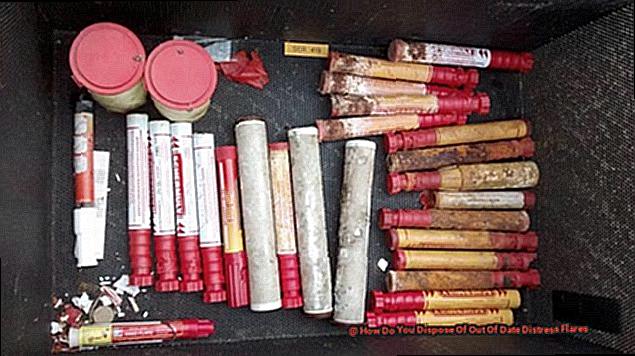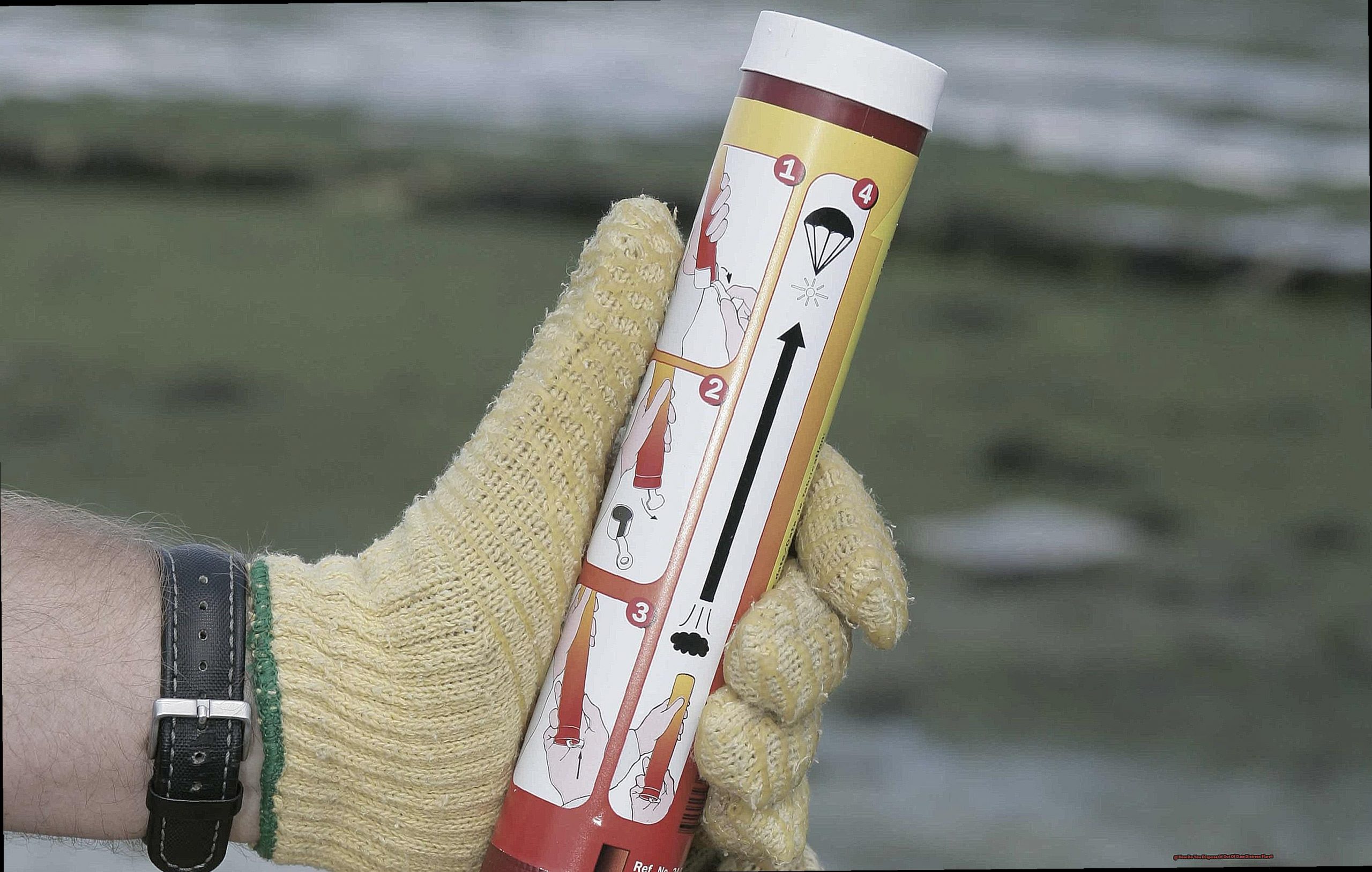Imagine you’re out on the open water, enjoying a beautiful day of boating.
Suddenly, your engine sputters and dies, leaving you stranded and in need of help. Luckily, you have distress flares on board to signal for assistance.
But what happens when those flares expire? Do you know how to dispose of them properly?
It’s not just about following regulations; it’s also about protecting the environment and others’ safety. In this blog post, we’ll cover everything you need to know about disposing of outdated distress flares.
Let’s get started.
How Do You Dispose Of Out Of Date Distress Flares?
Contents [show]
If so, it is important to dispose of them properly to ensure the safety of yourself and others. In this blog post, we will provide clear and concise instructions on how to safely dispose of out of date distress flares.
The first step in disposing of out of date distress flares is to check their expiration date. Most distress flares have a shelf life of three to four years, so it is important to keep track of when they were purchased and when they will expire. Different types of distress flares may also have different expiration dates, so be sure to check each one individually.
Once you have determined that your distress flares are out of date, the next step is to contact your local waste management authority or fire department for guidance on how to dispose of them properly. It is crucial to follow their instructions as distress flares contain hazardous materials that must be handled carefully. Do not attempt to dispose of expired flares in your regular household trash or by throwing them into the water.
It is also essential to research any specific guidelines or regulations for disposing of expired distress flares in your area. Some places may have designated drop-off locations or specific disposal methods that must be followed. It is crucial to follow these guidelines to ensure the safe and proper disposal of your out of date distress flares.
If you are unable to find any information from your local authorities on how to dispose of expired distress flares, you can also contact the manufacturer of the flares. They may have specific instructions or recommendations for proper disposal. In addition, some manufacturers may offer a recycling program for expired flares, which is a more environmentally-friendly option.
In some cases, you may be able to use up or repurpose your expired distress flares before disposing of them. Some boaters may choose to fire off their outdated flares during a practice drill, ensuring they are still in working condition. Others may use expired flares for signaling purposes during camping trips or hiking adventures. However, it is essential to check with local authorities and follow proper safety precautions when using expired flares.
The Hazards of Improper Disposal
As boaters, we know the importance of emergency preparedness on the water. One essential item in any boat’s safety kit is a distress flare. These brightly colored signals are used to alert others of an emergency and can save lives in dire situations.
But what happens when these flares expire? Are they still safe to have on board or should they be disposed of immediately? The answer is simple – expired distress flares can pose serious hazards if not disposed of properly.
The Dangers of Improper Disposal
The main danger of improper disposal is the potential for accidental detonation. These flares contain highly reactive chemicals and explosives, making them extremely dangerous if handled incorrectly. Even though the flare may be expired, it still retains its explosive properties and should be treated with caution.
Improper disposal can also lead to environmental pollution. The chemicals in the flares can contaminate soil and water sources, causing harm to wildlife and ecosystems. In fact, many accidents have occurred due to individuals attempting to dispose of flares on their own without proper knowledge or equipment.
In some cases, improper disposal of flares has caused wildfires and marine pollution. This not only puts lives at risk but can also result in legal consequences for individuals who do not follow proper disposal procedures.
Proper Disposal Methods
Now that we understand the hazards of improper disposal, let’s discuss how to safely handle expired distress flares.
Check Expiration Dates
The first step in proper disposal is knowing when your flares expire. Most manufacturers will include an expiration date on the packaging or the flare itself. It is important to check this regularly and replace any expired flares immediately.
Contact Local Authorities
Many local authorities offer disposal services for expired distress flares. This includes fire departments, police stations, and coast guard stations. Contact your local authorities to inquire about their disposal procedures and schedule a drop-off time.
Follow Specific Guidelines
Some areas may have specific guidelines for disposing of flares, so it is important to follow them closely. For example, some may require flares to be kept in a sealed container before disposal. Make sure to research and follow these guidelines to ensure proper disposal.
Checking Local Regulations and Laws
As a responsible boater, it is crucial to properly dispose of expired distress flares to avoid potential hazards and environmental pollution. However, the process of disposal may not be as simple as throwing them in the trash. It is essential to check your local regulations and laws before disposing of these flares to ensure safe and environmentally friendly methods are followed.
The Environmental Protection Agency (EPA) regulates the management and disposal of hazardous waste, which includes expired distress flares. Therefore, it is recommended to contact your local EPA office or state environmental agency for information on proper disposal methods. They can also advise if any permits are required for disposal.
In addition to federal regulations, some states may have designated facilities or programs for disposing of hazardous waste, including expired distress flares. It is crucial to research and follow these guidelines to prevent any potential harm to yourself or the environment.
Furthermore, some areas may have restrictions on where and how these flares can be disposed of. For example, some places may not allow them to be thrown in regular trash bins due to their hazardous nature. Therefore, it is crucial to check with your local fire department or coast guard for specific rules or recommendations on disposing of expired distress flares.
These authorities may also offer helpful information on proper disposal methods or even provide disposal services themselves. By following their guidelines and recommendations, you can ensure the safe and responsible disposal of these potentially dangerous items.
Contacting the Manufacturer for Disposal Instructions
Are you in possession of expired distress flares and unsure of how to dispose of them? As a responsible boater, proper disposal of these hazardous items is crucial for the safety of yourself, others, and the environment. The first step in disposal is often overlooked but is essential: contacting the manufacturer for specific instructions.
Why Contact the Manufacturer?
Each manufacturer may have different instructions and recommendations for disposing of their distress flares. This could be due to variations in product materials, expiration dates, or storage recommendations. By contacting the manufacturer, you can ensure that you are following the correct disposal method for your specific flare.
How to Find the Manufacturer’s Contact Information
The packaging or label of your distress flare may have contact information for the manufacturer. If not, a quick internet search using the brand and product name can provide the necessary information. It is important to have this information on hand before disposing of the flare.
What Information to Provide
When reaching out to the manufacturer, be sure to provide them with as much information as possible. This includes the brand, model, and expiration date of the flare. The manufacturer may also ask for details on how it was stored and if there were any damages or exposure to extreme temperatures or moisture.
Manufacturer Instructions vs. Local Regulations
Some manufacturers may provide specific instructions for disposing of their distress flares, while others may refer you to local regulations or disposal facilities. It is important to follow their instructions carefully or consult with local authorities for proper disposal methods. Improper disposal can be dangerous and harmful to the environment.
Take-Back Programs
In some cases, manufacturers may offer a take-back program where they will handle the disposal of expired flares for their customers. This is often the safest and most environmentally friendly option.
Utilizing Local Authority Programs or Events
Many people may not know the proper way to dispose of these potentially hazardous materials. As an expert on utilizing local authority programs or events, I’m here to share my knowledge and experience on how you can dispose of your expired distress flares responsibly.
Why Proper Disposal is Important:
Expired distress flares can pose a danger to both humans and the environment. These flares contain chemicals and substances that can be harmful if not disposed of properly. They also have the potential to start fires if not handled with care. By properly disposing of your expired distress flares, you’re not only ensuring your own safety but also protecting the environment.
Utilizing Local Authority Programs or Events:
Many local authorities have programs or events specifically for disposing of hazardous materials, including expired distress flares. These events are usually free and open to the public, making it easy for individuals to properly dispose of their expired distress flares without any hassle.
Some local authorities may also hold designated collection days for hazardous waste, which would be a great opportunity for individuals to dispose of their expired distress flares. It’s important to check with your local authority for specific guidelines and regulations on how to properly dispose of these items.
Community clean-ups or beach clean-ups are also great opportunities to get rid of your expired distress flares. These events often have designated areas for hazardous waste disposal, so be sure to ask the organizers if you can bring your expired distress flares for proper disposal.
Other Options:
If your local authority does not offer these programs or events, don’t worry. You can still dispose of your expired distress flares responsibly. Some local authorities may have drop-off locations or partnerships with local businesses for hazardous waste disposal, including expired distress flares. It’s best to contact them directly for information on how to properly dispose of your expired distress flares.

Seeking Professional Help for Safe Disposal
When it comes to safe disposal practices, it is crucial to seek professional help, especially when dealing with hazardous materials. This is especially true for out-of-date distress flares, which can pose potential dangers and hazards if not disposed of properly. As an expert on the topic, I am here to share valuable insights and tips on seeking professional help for disposing of expired flares.
Why is it important to seek professional help for disposing of out-of-date distress flares? The answer is simple – safety. Flares are not just simple fireworks; they contain chemicals that can ignite and cause fires or explosions if not handled correctly. Additionally, some flares may contain toxic substances that can harm the environment if not disposed of properly. By seeking professional help, you can ensure that these hazardous materials are handled and disposed of safely.
So who should you contact for professional disposal services? The Coast Guard and local hazardous waste management agencies are two options to consider. These professionals have the expertise and resources to handle hazardous materials safely. When contacting them, be sure to provide details about the type and quantity of flares you need to dispose of, as well as proof of purchase or ownership if required.
It is also important to understand any associated fees or regulations when using these services. While some may offer free disposal services, others may charge a fee. It is essential to inquire about costs beforehand and follow any regulations or guidelines set by these professionals for safe disposal.
Now, you may be wondering how to find reputable and certified professionals for disposal services. One way is to ask for recommendations from your local marina or boating association. These institutions often have experience with proper disposal practices and can recommend reliable professionals. You can also do research online or check with your local government agencies for a list of certified waste management companies in your area.
Proper Storage and Handling of Out of Date Distress Flares
As an expert on the topic of out-of-date distress flares, I cannot stress enough the importance of safe storage and handling. These seemingly harmless items can easily become hazardous if not properly stored and disposed of. In this section, I will share valuable insights and tips on keeping yourself and the environment safe from potential hazards.
Storage Is Key
The first step to ensuring the safety of out-of-date distress flares is proper storage. These flares should be kept in a cool, dry place away from any sources of heat or ignition. This will prevent them from igniting accidentally and causing harm.
Handle with Care
Out-of-date distress flares should always be handled with caution and care. It is important to never throw or drop them, as this can easily trigger an explosion. Before disposal, it is recommended to check for any residual charge by carefully examining the firing pin. If it is stuck or damaged, seek professional help immediately.
Disposal: Leave It to the Pros
When it comes to disposing of out-of-date distress flares, it is crucial to seek professional help. Attempting to disassemble them on your own can be extremely dangerous. Instead, consult with a professional or contact your local fire department for guidance.
Avoid Water at All Costs
Water and out-of-date distress flares do not mix well. These flares should be kept away from moisture as they can become unstable and cause harm. If they do come into contact with water, seek professional help immediately.
Conclusion
In conclusion, disposing of expired distress flares is not just a matter of following regulations; it’s a crucial step in protecting the environment and ensuring safety for all. As we’ve explored in this blog post, there are several important measures to take when getting rid of out-of-date flares. This includes checking expiration dates, seeking guidance from local authorities, researching specific guidelines and regulations in your area, and even consulting the manufacturer for proper disposal instructions.
We’ve also emphasized the dangers of improper disposal, such as accidental detonation and potential environmental harm. It’s essential to handle these hazardous materials with caution and seek professional assistance if needed.
Moreover, we’ve stressed the significance of storing and handling expired distress flares correctly. By keeping them in a cool, dry place away from sources of heat or ignition and avoiding contact with water, we can prevent any potential accidents.
As responsible boaters, it is our responsibility to ensure the safe disposal of expired distress flares. We must follow proper procedures to safeguard ourselves, others, and the marine ecosystem.





